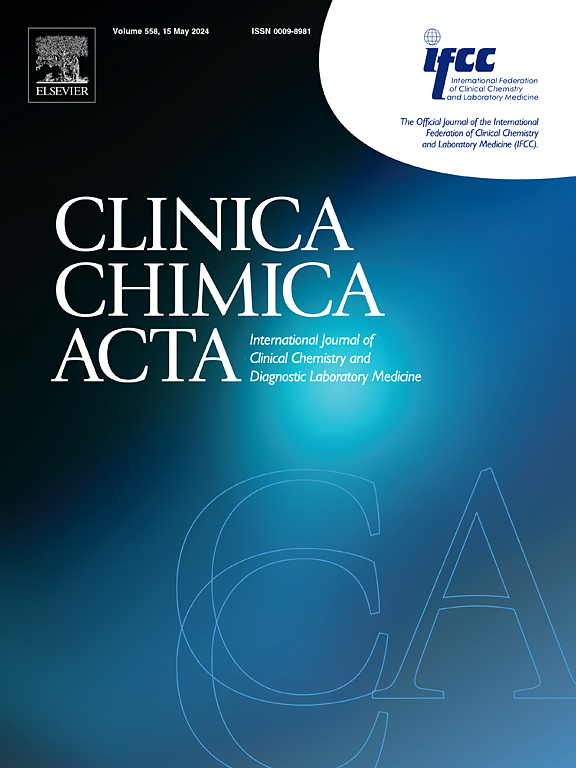Defining age-specific reference intervals for biomarkers distinguishing bacterial from viral infection in paediatrics
IF 3.2
3区 医学
Q2 MEDICAL LABORATORY TECHNOLOGY
引用次数: 0
Abstract
Differentiating bacterial from viral infections in children is a common clinical challenge. Novel host immune biomarkers have the potential to aid thediagnosis of infection aetiology and identify children who require antibiotics. Data on novel infection biomarkers gender and age-specific correlations, and reference intervals in healthy paediatrics is lacking. This study reports the plasma levels of three novel biomarkers that can aid in the differentiation of bacterial and viral infection in a healthy group of paediatrics. The levels of (Interferon-Gamma Inducible Protein 10 kDa (IP-10), Lipocalin-2 (LCN2) and TNF-Related Apoptosis-Inducing Ligand (TRAIL) were quantified in 199 plasma samples from healthy paediatrics aged 2 to 16 years old from across the UK. Reference intervals (2.5th and 97.5th) were determined, and biomarker levels were examined for sex and age associations. Reference intervals for IP-10, LCN2 and TRAIL for ages 2–16 years were 36.7–168.1 pg/ml, 14.2–123.3 ng/ml, 57.4–71.4 pg/ml respectively. No biomarker showed an association with sex and IP-10 did not show any association with age. TRAIL levels had a weak continuous negative correlation with age and LCN2 levels had a continuous positive correlation with age. Specific cut-offs for LCN2 in two age categories were identified, while TRAIL did not require age partitions. This study provides age-appropriate reference intervals for three biomarkers of infection in healthy children. These findings have the potential to improve the impact of future research on these biomarkers, the accuracy of clinical decision-making in children with infection, paediatric patient care and outcomes, and antimicrobial stewardship.
确定儿科细菌和病毒感染生物标志物的特定年龄参考区间。
区分儿童的细菌感染和病毒感染是一项常见的临床挑战。新的免疫生物标志物有可能诊断感染病因并确定需要使用抗生素的儿童。目前还缺乏有关这些生物标志物的性别和年龄相关性以及健康儿科参考区间的数据。本研究报告了健康儿科群体中三种新型生物标记物的血浆水平,它们有助于区分细菌和病毒感染。研究人员对英国各地 199 名 2-16 岁健康儿科患者的血浆样本中干扰素-γ 诱导蛋白 10 kDa (IP-10)、脂定位蛋白-2 (LCN2) 和 TNF 相关凋亡诱导配体 (TRAIL) 的水平进行了量化。确定了参考区间(2.5th 和 97.5th),并检查了生物标记物水平与性别和年龄的关系。2-16岁儿童的IP-10、LCN2和TRAIL参考区间分别为36.7-168.1 pg/ml、14.2-123.3 ng/ml和57.4-71.4 pg/ml。没有任何生物标志物与性别相关,IP-10与年龄也没有任何关系。TRAIL水平与年龄呈弱连续负相关,LCN2水平与年龄呈连续正相关。确定了两个年龄段的 LCN2 特定临界值,而 TRAIL 则不需要年龄分区。这项研究为健康儿童的三种感染生物标志物提供了与年龄相适应的参考区间。这些发现有可能提高未来对这些生物标志物研究的影响力、感染儿童临床决策的准确性、儿科患者护理和预后以及抗菌药物管理。
本文章由计算机程序翻译,如有差异,请以英文原文为准。
求助全文
约1分钟内获得全文
求助全文
来源期刊

Clinica Chimica Acta
医学-医学实验技术
CiteScore
10.10
自引率
2.00%
发文量
1268
审稿时长
23 days
期刊介绍:
The Official Journal of the International Federation of Clinical Chemistry and Laboratory Medicine (IFCC)
Clinica Chimica Acta is a high-quality journal which publishes original Research Communications in the field of clinical chemistry and laboratory medicine, defined as the diagnostic application of chemistry, biochemistry, immunochemistry, biochemical aspects of hematology, toxicology, and molecular biology to the study of human disease in body fluids and cells.
The objective of the journal is to publish novel information leading to a better understanding of biological mechanisms of human diseases, their prevention, diagnosis, and patient management. Reports of an applied clinical character are also welcome. Papers concerned with normal metabolic processes or with constituents of normal cells or body fluids, such as reports of experimental or clinical studies in animals, are only considered when they are clearly and directly relevant to human disease. Evaluation of commercial products have a low priority for publication, unless they are novel or represent a technological breakthrough. Studies dealing with effects of drugs and natural products and studies dealing with the redox status in various diseases are not within the journal''s scope. Development and evaluation of novel analytical methodologies where applicable to diagnostic clinical chemistry and laboratory medicine, including point-of-care testing, and topics on laboratory management and informatics will also be considered. Studies focused on emerging diagnostic technologies and (big) data analysis procedures including digitalization, mobile Health, and artificial Intelligence applied to Laboratory Medicine are also of interest.
 求助内容:
求助内容: 应助结果提醒方式:
应助结果提醒方式:


